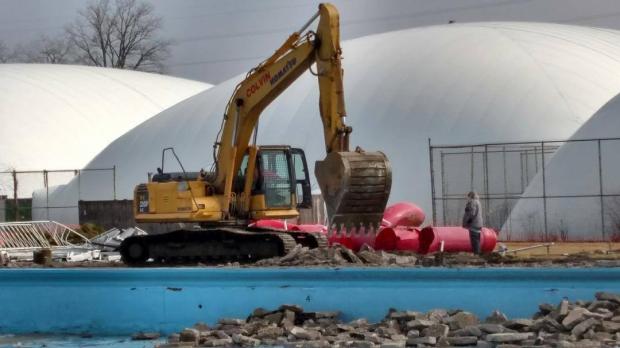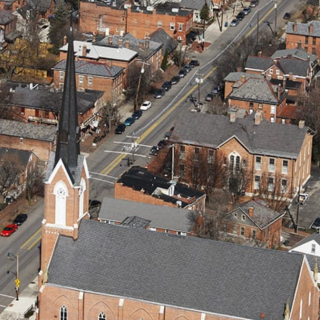Advertisement
Sara Nuber Thomas is a local amateur archaeologist who writes a blog called Expedition Finn: things to do in Ohio with a kid. The blog is named after her son of course, and through her day-trip expeditions she came across a 100-year-old archaeological map that showed the Central Ohio region dotted with Native American mounds and other peculiar looking earthworks. They wanted to see the mounds for themselves, and so they set out.
But what they found probably won’t surprise anyone, and she took pictures of what they saw and posted them on her blog. She ended up capturing images of aging country roads and newly built suburban houses, and of farmland too, but all the pictures were barren of anything created by the Native American pre-history cultures that once flourished here.
In a melancholy tone, Thomas wrote in her blog she doesn’t blame those who plowed the fields or built the homes. But she stated it’s “tragic” nonetheless that “so little care was shown” to the earthworks. According to Native American history, a magnificent burial mound believed the ceremonial center of Ohio was destroyed in the late 1830s, and its special burial clay used to make the first Ohio Statehouse.
Thomas decided to call the missing earthworks “Ghost Mounds”, hoping their disappearance will help protect “what few mounds and earthworks remain”.
“I always liked archaeology so it was natural progression to want to investigate these thousands-of-year-old sites that are in our own backyard, and a lot of Ohioans don’t realize this,” said Thomas to the Free Press. “When Ohioans think of archaeology, they think of the classics. Stonehenge, the Parthenon, Egyptian pyramids. They don’t realize that in Ohio we have sites that are just as old, or older.”
Thomas also volunteers at the Columbus-based Ohio Historical Society, which recently changed its name to the “Ohio History Connection”, perhaps an attempt to appeal to a younger, more (connected?) audience. Certainly not helping younger people connect to local history are the many Central Ohio historical points-of-interest that have withered in the face of destruction.
For instance, in much more recent times the Ohio Penitentiary was demolished for Nationwide Arena, but before the Ohio Pen was to be executed, there was a push to at least save its front façade. Blue Jacket fans still lament that the “Penalty Box” would have made a fairly cool and creative stadium nickname.
Clintonville also remains sullen over last summer’s closure of its Olympic Swim Club, a privately owned 76-year-old community pool and magnet that had a nostalgic mid-20th century look and feel. Developers such as Kyle Katz, who purchased the pool’s property, may scoff it was just an old pool that only produced one Olympic athlete, diver Katie Bell from the 2012 London games who was born premature and not expected to survive infancy. Undoubtedly Katz never would rehab the pool because its profit margins would never be up to his liking. So rising out of the pool’s rubble is a trustafarian-ish, high-end apartment complex with spacious parking and exciting commercial space.
Looking in from the outside are perhaps those who have the utmost right to criticize Central Ohio’s missing history. Brad Lepper is the Ohio History Connection’s most public archaeologist, and when he posted a top-ten list of Ohio’s greatest earthworks, an anonymous Native American called out the entire state. Keep in mind many of his ancestors were forced to leave the state during the “Ohio Removal” years of the early 1800s.
“As a person of Native American ancestry, I believe that Ohio can and should do a lot more about educating Ohioans, and everyone else, about the wonderful history that is held within this state’s boundaries,” he wrote. “There are numerous places where historical Native American events took place that are either poorly marked, or not marked at all. Come on, OHIO! Get with it!”
Far worse criticism came this past June when Native Americans held their annual “National Sacred Places Prayer Day”. Those who organized the event told the popular Indian Country Today website “the most egregious and ongoing degradation” continues in Ohio. Particularly at The Mound Builders Country Club, a private golf course built within and around the Newark Circle and Octagon. These earthworks have mind-bending celestial alignments, yet because part of these earthworks are on private property, it marginalizes the earthworks chances from becoming a UNESCO World Heritage Site.
Nevertheless, The Ohio History Connection continues to lobby UNESCO (an office of the United Nations) to designate the Newark Earthworks a World Heritage site.
“A World Heritage designation would significantly increase tourism to Ohio and have tremendous economic impact on the site,” said Emmy Beach, Ohio History Connection spokesperson to the Free Press.
Even so, the Ohio Historical Connection is not a regulatory agency of the state that has the power to act autonomously within the private sector economy, she said.
“We cannot regulate private property owners about changes to historic properties, like the Olympic Swim Club,” she said. “Because Olympic Swim Club was private property demolished by a private developer, we were not involved in that process.”
But that doesn’t mean a community can’t try to change the course of history when the history is facing extermination. The Ohio History Connection offers this advice to help communities preserve properties in their neighborhood:
Nominate eligible properties to the National Register of Historic Places; this won’t ultimately prevent demolition, but will help raise awareness and could help owners with tax credits if they are considering rehabbing their property. If your community has a local historic preservation ordinance and a local register of historic properties, such as the Columbus Register of Historic Properties, nominate the place. If your community does not have a local historic preservation ordinance, work with or demand local elected officials to create one.
The Free Press asked The Ohio History Connection about the name change and other efforts to stem the tide of young people turning away from history. One local professor of archaeologist who does not work for the Ohio History Connection suggested to the Free Press maybe it’s time his peers began investigating what some call “fringe” history.
When Scott Wolter, host of the hugely popular History Channel show America Unearthed, shows the world a miniature Egyptian obelisk that was dug up generations ago from a Native American earthwork by Midwestern farmers, should that lead be pursued by The Ohio History Connection? State taxpayers by the way paid $15 million towards the Ohio History Connection’s $24 million budget for 2015.
“Fringe history is unsubstantiated history,” says Beach. “To date there is no reliable evidence for any claims put forth by Scott Wolter’s television program. There is, on the other hand, abundant evidence that indigenous people of the America’s accomplished tremendous feats of art, architecture, and engineering without the help of Old World civilizations or ancient aliens.”
As for the name change, Beach said after two years of research, an overwhelming number of respondents said the names “historical” and “society” were too exclusive and antiquated.
“This is the exact opposite of what we are and what we aim to be,” she said. “We believe the Ohio History Connection communicates our service in the simplest way possible: assisting people with accessing, preserving and sharing Ohio’s past.”




